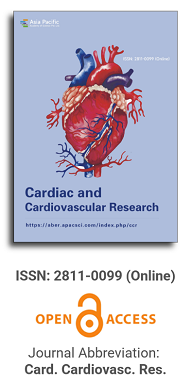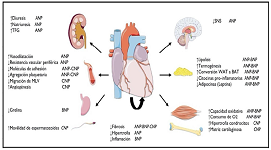
Asia Pacific Academy of Science Pte. Ltd. (APACSCI) specializes in international journal publishing. APACSCI adopts the open access publishing model and provides an important communication bridge for academic groups whose interest fields include engineering, technology, medicine, computer, mathematics, agriculture and forestry, and environment.

Workers particularly sensitive to cardiovascular risk
Vol 2, Issue 1, 2021
Download PDF
Abstract
Background: Of the 607 fatal occupational accidents that occurred in Spain in 2016, 37.9% were due to ischemic heart disease and stroke. Working conditions such as night work, noise or respiratory contaminants were associated with a higher cardiovascular incidence. The aim of the present study was to assess whether health surveillance in workers exposed to these conditions should include assessment of cardiovascular risk. Subjects and methods: A cross-sectional study was conducted in 680 workers in a public administration. The qualification of working conditions was obtained from the company risk assessment and from personal, anthropometric and analytical data, which allowed the assessment of cardiovascular risk in the medical examination performed in 2015. Results: 30.1% of the sample were exposed to these working conditions, with significant differences by sex (37% in men, 11.9% in women, p<0.05). According to REGICOR, 13.2% of those exposed were classified as particularly sensitive to cardiovascular risk. Conclusions: A large percentage of workers are exposed to TC related to a greater prevalence of cardiovascular pathology. The percentage of workers classified as especially sensitive to cardiovascular risk among those exposed suggests that this risk should be assessed in occupational health surveillance when there are working conditions related to cardiovascular pathology.
Keywords
References
- Madrid. Date published February 27, 2017. Available online: http://www.ine.es/prensa/edcm_2015.pdf (accessed on 5 June 2021).
- Fernández-Simal F. Myocardial infarction as an occupational accident. Available online: http://www.ucm.es/data/cont/docs (accessed on 5 June 2021).
- Madrid. Employment. Gov. Available online: http://www.empleo.gob.es/estadisticas/eat/eat16dicAv/ATR_12_2016_Resumen.pdf (accessed on 5 June 2021).
- Marmot MG, Stanfeld S, Patl C, et al. Health inequalities among British civil servants: the White Hall II study. The Lancet. 1991; 337(8754): 1387-1393. doi: 10.1016/0140-6736(91)93068-K
- Vyas MV, Garg AX, Iansavichus AV, et al. Shift work and vascular events: Systematic review and meta-analysis. BMJ. 2012.
- Jorgensen JT, Karlsen S, Stayner L, et al. Shift work and overall and cause-specific mortality in the Danish nurse cohort. Scand J Work Environ Health. 2017; 43(2): 117–126.
- Jankowiak S, Backé E, Liebers F, et al. Current and cumulative night shift work and subclinical atherosclerosis: Results of the Gutenberg Health Study. Int Arch Occup Environ Health. 2016; 89(8): 1169–1182.
- Kang W, Park WJ, Kim SH, et al. Coronary artery atherosclerosis associated with shift work in chemical plant workers by using coronary CT angiography. Occup Environ Med. 2016; 73(8): 501–513.
- Bokenberger K, Sjolander A, Dahl-Aslan AK, et al. Shift work and risk of incident dementia: a study of two population-based cohorts. Eur J Epidemiol. 2018; 33(10): 977–987.
- Gan Y, Yang C, Tong X, et al. Shift work and diabetes mellitus: a meta-analysis of observational studies. Occup Environ Med. 2015; 72(1): 72–84.
- Hansen J. Night Shift Work and Risk of Breast Cancer. Curr Environ Health Rep. 2017; 4(3): 325–339.
- Travis RC, Balkwill A, Fensom GK, et al. Night Shift Work and Breast Cancer Incidence: Three prospective studies and meta-analysis of published studies. Natl Cancer Inst. 2016; 108(12): 46–52.
- Ijaz S, Verbeek J, Seidler A, et al. Night-shift work and breast cancer-a systematic review and meta-analysis. Scand J Work Environ Health. 2013; 39(5): 431–447.
- Kamdar BB, Tergas AI, Mateen FJ, et al. Night-shift work and risk of breast cancer: a systematic review and meta-analysis. Breast Cancer Res Treat. 2013; 138(1): 291–301.
- Kolstad HA. Nightshift work and risk of breast cancer and other cancers - a critical review of the epidemiologic evidence. Scand J Work Environ Health. 2008; 34(1): 5–22.
- Dzhambov AM, Dimitrova DD. Occupational noise and ischemic heart disease: A systematic review. Noise Health. 2016; 18(83): 167–177.
- SobotovaL, Jurkovicova J, Stefanikova Z, et al. Community response to environmental noise and the impact on cardiovascular risk score. Sci Total Environ. 2010; 408(6): 1264–1270.
- Huo Yung Kai S, Ruidavets JB, Carles C, et al. Impact of occupational environmental stressors on blood pressure changes and on incident cases of hypertension: a 5-year follow-up from the VISAT study. Environ Health. 2018; 17(1): 79–85.
- Yaghoubi K, Alimohammadi I, Abolghasemi J, et al. The effect of occupational noise exposure on systolic blood pressure, diastolic blood pressure and salivary cortisol level among automotive assembly workers. Int J Occup Saf Ergon. 2018; 24: 1–6.
- Skogstad M, Johannessen HA, Tynes T, et al. Systematic review of the cardiovascular effects of occupational noise. Occup Med Lond. 2016; 66(1): 10–16.
- Girard SA, Leroux T, Verrault R, et al. Cardiovascular disease mortality among retired workers chronically exposed to intense occupational noise. Int Arch Occup Environ Health. 2015; 88(1): 123–130.
- Theorell T, Jood K, Jarvholm LS, et al. A systematic review of studies in the contributions of the work environment to ischaemic heart disease development. Eur J Public Health. 2016; 26(3): 470–477.
- Zare Sakhvidi MJ, Zare Zakhvidi F, Mehrparvar AH, et al. Association between noise exposure and diabetes: A systematic review and meta-analysis. Environmental Res. 2018; 166: 647–657.
- Muratsubaki T, Hattori T, Li J, et al. Relationship between Job Stress and Hypo-high- density Lipoproteinemia of Chinese Workers in Shanghai: The Rosai Karoshi Study. Chin Med J. 2016; 129(20): 2409–2415.
- Hwang WJ, Park Y. Ecological Correlates of Cardiovascular Disease Risk in Korean Blue-collar Workers: A Multi-level Study. J Korean Acad Nurs. 2015; 45(6): 857–867.
- Biglari H, Ebrahimi MH, Salehi M, et al. Relationship between occupational stress and cardiovascular diseases risk factors in drivers. Int J Occup Med Environment Health. 2016; 29(6): 895–901.
- Magnavita N, Capitanelli I, Garbarino S, et al. Work-related stress as a cardiovascular risk factor in police officers: a systematic review of evidence. Int Arch Occup Environ Health. 2018; 91(4): 377–389.
- Kivimaki M, Jokela M, Singh-Manoux A, et al. Long working hours and risk of coronary heart disease and stroke: a systematic review and meta-analysis of published and unpublished data for 603,838 individuals. Lancet. 2015; 386(10005): 1739–1746.
- Fransson EI, Nyberg ST, Heikkila K, et al. Job strain and the risk of stroke: an individual-participant data meta-analysis. Stroke. 2015; 46(2): 557–569.
- Mannoci A, Lojodice B, Boccia A, et al. Systematic review of the literature regarding the risk of mortality, cancer and cardiovascular diseases in professional drivers. Sanita igPubbl. 2013; 69(2): 155–170.
- Krzowski B, Platek AE, Szymanski FM, et al. Epidemiology of dysli-pidaemia in professional drivers: results of RACER-ABPM (Risk of Adverse Cardiovascular Events among professional Rivers in Poland-Ambulatory Blood Pressure Monitoring) study. Kardiol Pol. 2018; 76(2): 396–400.
- Mocevic E, Kristiansen P, Bonde JP. Risk of ischemic heart disease following occupational exposure to welding fumes: a systematic review with meta-analysis. Int Arch Occup Environ Health. 2015; 88(3): 259–272.
- Morfeld P, Mundt KA, DSell LD, et al. Meta-Analysis of Cardiac Mortality in Three Cohorts of Carbon Black Production Workers. Int J Environ Res Public Health. 2016; 13(3): 156–164.
- Chowdhury R, Ramnd A, O’Keeffe LM, et al. Environmental toxic metal contaminants and risk of cardiovascular disease: Systematic review and meta-analysis. BMJ. 2018; 362: 3310–3315.
- Marrugat J, Subirana I, Comín E, et al. Validity of an adaptation of the framingham cardiovascular risk function: the VERIFICA study. J Epidemiol Community Health. 2007; 61: 40–47.
- Sans S, Fitzgerald A, Royo D, et al. Calibration of the SCORE cardiovascular risk chart for Spain. Rev Esp Cardiol. 2007; 60(5): 476–485.
- Comín E, Solanas P, Cabezas C, et al. Performance of cardiovascular risk estimation in Spain using different functions. RevEspCardiol. 2007; 60(7): 693–702.
- Marrugat J, Vila J, Baena-Díez JM, et al. Relative validity of 10-year cardiovascular risk estimation in a population-based cohort of the REGICOR study. Rev Esp Cardiol. 2011; 64(5): 385–394.
- Hermida-Ameij eiras Á, López-Paz JE, Riveiro-Cruz MA, Calvo-Gómez C. Carotid intima-media thickness distribution according to the stratification of cardiovascular risk by means of Framingham-REGICOR and score function charts. Hypertens Riesgo Vasc. 2016; 33(2): 51–57.
- Piepoli MF, Hoes AW, Agewall S, et al. European guidelines on cardiovascular disease prevention in clinical practice. Eur Heart. 2016; 37: 2315–2321.
- Tauler R Bennasar-Veny M, Morales-Asencio JM, López-González AA, et al. Prevalence of Premorbid metabolic syndrome in Spanish adult workers using IDF and ATPIII diagnostic criteria: relationship with cardiovascular risk factors. PLoS One. 2014; 9(2): 89–92.
- Martínez-González MA, López-Fontana C, Varo JJ, et al. Validation of the Spanish version of the physical activity questionnaire used in the Nurses, Health Study and the Health Professionals5 Followup Study. Public Health Nutr. 2005; 8: 920–927.
- Fernández-Bergés D, Cabrera A, Sanz H, et al. Metabolic syndrome in Spain: prevalence and coronary risk associated with the harmonized definition and that proposed by the WHO. DARIOS study. RevEspCardiol. 2012; 65(3): 241–248.
- Division-Garrote JA, Massó-Orozco J, Carrión-Valero L, et al. Trends in prevalence of risk factors and global cardiovascular risk in general population of albacete, Spain (199294 to 2004-06). Rev Esp Salud Publica. 2011; 85(3): 275–284.
- Amor AJ, Masana L, Soriguer F, et al. Estimation of cardiovascular risk in Spain according to the European guideline on cardiovascular disease prevention in practice. Clinical. RevEspCardiol. 2015; 68(5): 417–425.
- López-González A, Bennasar-Veny M, Tauler P, et al. Socioeconomic inequalities and sex and age differences in cardiovascular risk factors. GacSanit. 2015; 29(1): 27–36.
- Yang SC, Chien KL, Tsai WI, et al. The estimated risk for coronary heart disease and prevalence of dysli- pidemia among workers of information technology industries in Taiwan. Clin Chim Acta. 2011; 412(7–8): 569–573.
Supporting Agencies
Copyright (c) 2022 Álvarez-Fernández Álvarez-Fernández, Vaquero-Abellán Manuel, Romero-Saldaña Manuel, Álvarez-López Carlos

This work is licensed under a Creative Commons Attribution 4.0 International License.

This site is licensed under a Creative Commons Attribution 4.0 International License (CC BY 4.0).

Prof. Prakash Deedwania
University of California,
San Francisco, United States




